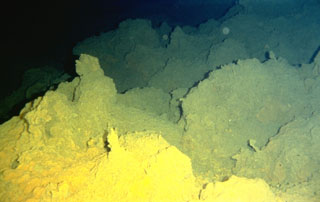Report on Kama'ehuakanaloa (United States) — September 2001
Bulletin of the Global Volcanism Network, vol. 26, no. 9 (September 2001)
Managing Editor: Richard Wunderman.
Kama'ehuakanaloa (United States) Earthquake swarm during 10-13 September 2001
Please cite this report as:
Global Volcanism Program, 2001. Report on Kama'ehuakanaloa (United States) (Wunderman, R., ed.). Bulletin of the Global Volcanism Network, 26:9. Smithsonian Institution. https://doi.org/10.5479/si.GVP.BGVN200109-332000
Kama'ehuakanaloa
United States
18.92°N, 155.27°W; summit elev. -975 m
All times are local (unless otherwise noted)
On the afternoon of 10 September 2001 an earthquake swarm began at Lōʻihi. The swarm began with a M 5 earthquake and was followed by M 3.5-4.9 earthquakes until the morning of 11 September. This was the most severe swarm at Lōʻihi since July 1996, when the summit collapsed. Two earthquakes that occurred on 13 September may have also been part of the swarm. The two later earthquakes occurred at 0311 and 0839 and had magnitudes of 4.9 and 4.4, respectively. Most of the earthquakes from 10-13 September were ~12 km deep and located slightly S of Lōʻihi's summit.
Background. Lōʻihi seamount, the youngest volcano of the Hawaiian chain, lies about 35 km off the SE coast of the island of Hawaii. Lōʻihi (which is the Hawaiian word for "long") has an elongated morphology dominated by two curving rift zones extending north and south of the summit. The summit region contains a caldera about 3 x 4 km wide and is dotted with numerous lava cones, the highest of which is about 975 m below the sea surface. Deep and shallow seismicity indicate a magmatic plumbing system distinct from that of Kīlauea volcano. Abundant fresh, sediment-free lavas attest to the youthful age of the volcano. During 1996, a new pit crater was formed at the summit of the volcano and lava flows were erupted.
The summit platform includes two well-defined pit craters, sediment-free glassy lava, and low-temperature hydrothermal venting. An arcuate chain of small cones on the W edge of the summit extends N and S of the pit craters and merges into the crests of Lōʻihi's prominent N and S rift zones (Fornari and others, 1988). Continued volcanism is expected to eventually build a new island at Lōʻihi; time estimates for the summit to reach the surface range from roughly 10,000 to 100,000 years.
Geological Summary. The Kama’ehuakanaloa seamount, previously known as Loihi, lies about 35 km off the SE coast of the island of Hawaii. This youngest volcano of the Hawaiian chain has an elongated morphology dominated by two curving rift zones extending north and south of the summit. The summit region contains a caldera about 3 x 4 km and exhibits numerous lava cones, the highest of which is about 975 m below the ocean surface. The summit platform also includes two well-defined pit craters, sediment-free glassy lava, and low-temperature hydrothermal venting. An arcuate chain of small cones on the western edge of the summit extends north and south of the pit craters and merges into the crests prominent rift zones. Seismicity indicates a magmatic system distinct from that of Kilauea. During 1996 a new pit crater formed at the summit, and lava flows were erupted. Continued volcanism is expected to eventually build a new island; time estimates for the summit to reach the ocean surface range from roughly 10,000 to 100,000 years.
Information Contacts: Hawaiian Volcano Observatory (HVO), U.S. Geological Survey, PO Box 51, Hawaii National Park, HI 96718, USA (URL: https://volcanoes.usgs.gov/observatories/hvo/).

